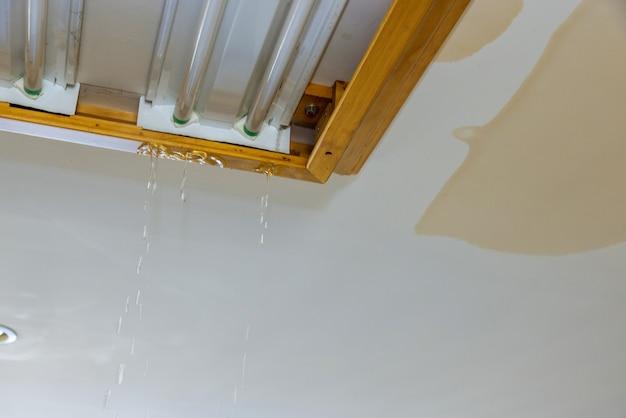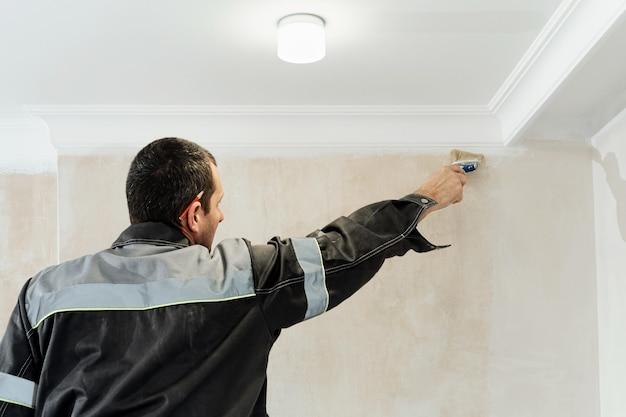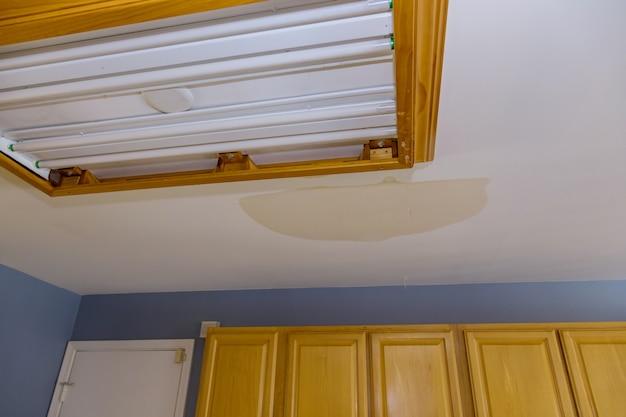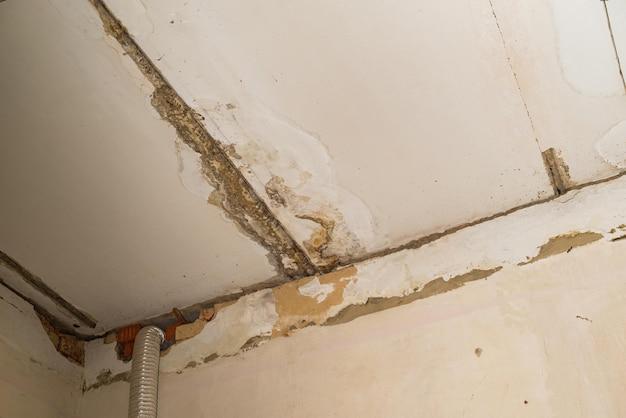Have you ever experienced a ceiling leak from rain or a burst pipe? It can be frustrating, not to mention costly if it’s not identified and repaired promptly. But, what causes ceiling leaks? There are numerous reasons why your ceiling might be leaking, and it’s crucial to identify the cause to avoid further damage. In this blog post, we’ll explore the common factors that can cause a leak in the ceiling, how to stop leakage from ceiling, what to do when your ceiling is leaking, and who to call for a water leak in the ceiling. Let’s get started!
What Can Cause a Leak in the Ceiling
Have you ever walked into your room, only to find water dripping from the ceiling? It’s the ultimate nightmare scenario for homeowners, but don’t panic just yet! There are several possible causes of a leaky ceiling, and most can be easily fixed.
Faulty Roofing
One obvious reason for a leaky ceiling is a problem with your roof. If your roof is old, damaged, or improperly installed, water can seep in through the shingles and into your home. This is bad news if you live in an area with heavy rainfall or snow, as this can exacerbate the problem.
Clogged Gutters
Another issue that can lead to a leaky ceiling is clogged gutters. When leaves, sticks, and other debris accumulate in your gutters, water can overflow and seep into your ceiling. This is an easy fix, so don’t let it get out of hand.
Plumbing Problems
Sometimes, a leaky ceiling can be caused by an issue with your plumbing. If you have a bathroom or kitchen that’s located above your leaky ceiling, there might be a leak in one of the pipes or fixtures. If this is the case, you’ll need to call a plumber to fix the problem.
Condensation
Believe it or not, condensation can also cause a leaky ceiling. When warm, moist air from your home meets cold air in the attic, it can create condensation that drips onto the ceiling below. Make sure your attic is properly insulated to prevent this problem.
A leaky ceiling is nothing to sneeze at, but it’s important to stay calm and identify the cause of the problem. Whether you need a new roof or a simple gutter cleaning, there are plenty of solutions available. Just don’t forget to call in the professionals if you need help!
Ceiling Leak From Rain
When it rains, it pours and sometimes, it pours into our homes. A ceiling leak from rain can be a real bummer, especially when you’re trying to relax on the couch and watch your favorite show. Here are some reasons why this might happen:
Roof Damage
Your roof is the first line of defense against the elements, so it’s no wonder that it can sustain damage over time. Things like missing shingles, cracked tiles, or damaged flashing can allow rainwater to seep through your roof and into your ceiling. It might be time to call in a professional to take a closer look.
Clogged Gutters
Gutters are designed to redirect rainwater away from your roof and foundation, but they can’t do their job if they’re clogged with leaves or other debris. When rainwater backs up in your gutters, it can overflow and spill onto your roof, which can lead to a ceiling leak. Grab a ladder and clear out those gutters!
Poorly Sealed Windows or Doors
If you notice that your ceiling is leaking near a window or door, it could be because they’re not properly sealed. When rainwater gets in around the edges, it can seep down and cause a ceiling leak. Check your windows and doors for any gaps or cracks and seal them up with caulk or weatherstripping.
Animals
Believe it or not, animals can cause a ceiling leak from rain. Birds and rodents can find their way into your attic and create holes in your roof. Even worse, they might make a nest up there and create a leak from all the urine and feces. Yuck! Make sure your attic is secure and free of any unwanted guests.
A ceiling leak from rain can be a real headache, but don’t sweat it – there’s usually a simple fix. Just remember to check your roof, gutters, windows, doors, and attic for any signs of damage or intrusion. And if all else fails, just grab a bucket and a mop and embrace the rainy day vibes.
What Causes Ceiling Leaks
Ceiling leaks are not only messy and inconvenient, but they can also cause significant damage to your property. The causes of ceiling leaks can vary depending on several factors like weather conditions, plumbing issues, and roof problems. In this section, we’ll explore the different reasons that can cause a leak in the ceiling, and why it’s essential to identify the problem promptly.
Plumbing Issues
One of the most common culprits of ceiling leaks is plumbing problems. Leaky pipes and blocked drains can often cause water to back up into your ceiling and eventually leak. If you notice a ceiling leak, it’s crucial to have your plumbing inspected by a professional plumber as soon as possible. They can identify the source of the problem and fix it before it leads to more costly damages.
Roof Problems
Roof problems are another common cause of ceiling leaks. Damaged or missing shingles, cracked roof tiles, and poorly installed flashing can often let water seep in and cause a leak in the ceiling. It’s essential to have your roof inspected at least once a year by a professional roofer to ensure it’s in good condition. A well-maintained roof can prevent significant damage to your property and save you money in costly repairs.
Weather Conditions
Severe weather conditions can also cause a leak in the ceiling. Heavy rain and snow can cause water to seep into the roof and eventually make its way into your home’s interior. Additionally, extreme temperatures can cause the roof to expand and contract, resulting in cracks and leaks. You can prevent ceiling leaks caused by weather conditions by ensuring your roof is well-insulated and free from any damage.
Other Factors
Other factors that can cause a ceiling leak include condensation, inadequate ventilation, and improper installation of windows or skylights. Whatever the cause, it’s crucial to identify the problem quickly to prevent further damage to your property. If you’re unsure what’s causing the leak, it’s best to contact a professional to inspect your property and identify the underlying issue.
In conclusion, identifying the cause of a ceiling leak is crucial in preventing further damage to your property. Whether it’s plumbing issues, roof problems, or severe weather conditions, it’s essential to address the problem quickly and efficiently. So, if you notice a leak in your ceiling, don’t hesitate to contact a professional to inspect your property and identify the underlying issue.
How to Stop Leakage from Ceiling
Imagine yourself snuggled up in your bed, enjoying a good book on a rainy day, and suddenly, you hear a dripping sound from above. You look up to the ceiling and realize that there’s a leak. Don’t panic! Here are some ways to stop leakage from ceiling:
Identify the Source of the Leak
Before you can fix the ceiling leak, you need to locate the source of the water. Sometimes, the origin of the leak is not directly above the drip, but rather, it could be a few feet away. Use your detective skills to trace the water path to the source of the problem.
Fix the Leak
Once you identified the source of the leak, it’s time to fix it. If the problem is a loose pipe joint, tighten it with a pipe wrench. If it’s a cracked pipe, you might need to replace the section of the pipe.
Apply Sealant or Caulk
If you can’t locate the source of the leak or the fix doesn’t work, you can apply sealant or caulk to the affected area. Apply the sealant or caulk generously to the ceiling and let it dry for at least 24 hours.
Paint the Ceiling
After the ceiling has dried completely, you can paint it to match the rest of the room. Use a roller or a brush to apply the paint evenly. You can also add a pop of color to the ceiling to make it look more interesting.
Call a Professional
Sometimes, fixing a ceiling leak requires the services of a professional. If you’re not comfortable fixing the leak yourself or if the damage is extensive, call a trusted plumber or contractor to help you out.
In conclusion, stopping leakage from the ceiling can be a daunting task, but with the right tools and approaches, you can fix it like a pro.
Brown Water Leaking from Ceiling
Have you ever woken up to the sound of water dripping from your ceiling and thought to yourself, “I guess it’s raining inside now”? Well, don’t panic just yet. You’re not the only one who has experienced this phenomenon. Sometimes, the water can have a brownish or yellowish tint, and that is definitely not a good sign. Here are some possible reasons why brown water could be leaking from your ceiling.
Burst Pipes
One possibility for brown water leaking from your ceiling could be a burst pipe. As annoying as it may sound, this is actually one of the most common problems that can cause brown water. Pipes can burst due to various reasons, such as old age, extreme temperature changes, or just plain bad luck. If you suspect that this is the cause of your brown water woes, it’s best to call a plumber ASAP.
Roof Problems
Another possibility for brown water is that your roof might have some issues that need to be addressed. If your roof is old, damaged, or poorly installed, water can seep through and cause damage to your ceiling. The brown color could be due to debris or rust that has accumulated on your roof and mixed with the water. In this case, it’s best to call a roofing specialist to inspect your roof and recommend the necessary repairs.
Faulty Appliances
If you live in an apartment or multi-story building, your brown water could be caused by an appliance malfunction. Water heaters, air conditioning units, and washing machines are all examples of appliances that can leak and cause damage to the ceiling below. If you suspect that one of your appliances is the culprit, it’s best to call a professional repair person to fix the issue.
Leaking Toilet
Believe it or not, your toilet can also be the source of brown water dripping from your ceiling. If your toilet has a leaky seal, it can cause water to drip below and mix with waste, resulting in unsightly brown water. Although this may sound disgusting, it’s a common problem that can be easily fixed by a plumber.
As you can see, brown water leaking from your ceiling can be caused by various factors, ranging from burst pipes to faulty appliances. The key is to identify the root cause of the problem and fix it as soon as possible to prevent further damage. If you suspect that brown water is coming from your ceiling, don’t hesitate to call a professional to help.
Temporary Fix for Leaking Ceiling
So, you’re enjoying a peaceful evening at home when suddenly, drip, drip, drip. You look up, and to your dismay, you see water droplets spreading on your ceiling.
Before calling in for a repair, there are a few temporary fixes to hold you over till the experts arrive.
Locate the Source
First things first, locate the source of the leak. But be warned, it’s not always apparent and may require some Sherlock Holmes skills. Check the attic, roof, and any second-story plumbing. Once you locate the source, place a bucket under the leak site to catch the water.
Seal the Leak
Cover the leak site with a waterproof sealant. You can use silicone caulk or a similar product to stop the leak temporarily. Ensure to apply the sealant to the exterior as well as the interior, as water can travel a long way.
Use Duct Tape
Duct tape has undoubtedly saved the day on multiple occasions. In a pinch, apply some duct tape on both sides of the leak site. Use a plastic sheet over the duct tape to slow down the leak.
Improve Drainage
If the water is collecting on the roof, make sure the gutters and downspouts are clear of debris, and the water is draining correctly. You can also place a piece of aluminum foil under the shingles to channel the water towards the gutters.
Place a Bucket or Bowl
Till the repair specialist arrives, place a bucket or bowl under the leak site. You don’t want to end up with a lake in your living room, so ensure to empty the bucket regularly.
So there you have it, folks, an easy way to hold off a leaky ceiling till an expert to arrive. Remember, these fixes are temporary, and it’s crucial to schedule a repair because leaks can lead to significant water damage and mold growth.
What Can Cause a Hole in the Ceiling
Let’s face it; sometimes, holes in the ceiling can be a real headache. They can appear out of nowhere, and the reasons behind them are not always clear.
But fear not, my friend. In this section, we’ll explore some of the most common causes of holes in the ceiling, and maybe we can even share a laugh or two.
Plumbing Issues
One possible cause of a hole in your ceiling could be an issue with your plumbing. If there is a leak in your pipes, water could slowly seep through your ceiling, causing damage and eventually leading to a hole.
So, next time you hear a dripping sound in your ceiling, don’t ignore it. Call a plumber ASAP!
Pest Infestations
Those pesky little critters can cause more damage than you may think. Termites, rats, and even squirrels can chew through your ceiling, creating a hole.
If you suspect that you have a pest problem, call an exterminator to take care of it before the damage gets worse.
Faulty Wiring
Another potential cause of a ceiling hole could be faulty wiring. If your wiring is old and frayed, it could catch fire and burn through your ceiling.
If you notice any electrical issues in your home, call a licensed electrician to come and inspect your wiring.
Natural Wear and Tear
Over time, your ceiling can wear down, creating weak spots that can eventually lead to holes. This is especially true if your home is older and has not been properly maintained.
To prevent wear and tear from causing ceiling holes, make sure to inspect your ceilings regularly and make repairs as needed.
Out of This World (Literally)
Believe it or not, holes in the ceiling can sometimes have a much more otherworldly explanation. For example, if a meteorite were to fall from space and strike your home, it could create a hole in your ceiling (and maybe even your roof).
While this is not a very likely occurrence, it’s always good to stay vigilant, you never know what could happen.
While there may be many potential causes of a hole in your ceiling, there’s no need to panic. By staying vigilant and addressing any issues as they arise, you can keep your home in great condition.
So, go forth and conquer the mystery of the ceiling hole, my friend!
Who to Call for a Water Leak in the Ceiling
So you’ve got a leak in your ceiling, and you don’t know what to do. Don’t stress, we’ve got your back. Here’s a guide to figuring out who to call when your ceilin’ is leakin’.
Step 1: Determine the Severity of the Leak
First things first, you need to figure out how bad the leak is. If it’s a little drip that you can easily catch with a bucket, you might be able to wait until tomorrow to call someone. But if it’s a steady flow of water that’s causing damage to your house, you need to call someone ASAP.
Step 2: Call a Plumber
If the problem is a plumbing issue, you need to call a plumber. Plumbers are licensed professionals who are trained to fix all sorts of plumbing problems, including leaks in your ceiling.
Step 3: Call a Roofer
If the problem is an issue with your roof, you need to call a roofer. Roofers are trained to fix all sorts of problems with roofs, including leaks.
Step 4: Call a Handyman
If you’re not sure what’s causing the leak, you could call a handyman. Handyman are able to fix a wide range of household problems, and they might be able to help you identify the source of the leak.
Step 5: Call Your Insurance Company
If the leak is causing damage to your home, such as damage to your paint, drywall, or flooring, you should call your home insurance company. They’ll be able to talk you through the steps you need to take to get the damage fixed, and they might be able to recommend a contractor to help you with the repairs.
Step 6: Take Action
No matter who you decide to call, make sure you take action to fix the leak as soon as possible. Water damage can cause all sorts of problems to your home, including mold growth, which can be harmful to your health.
That’s it! With these steps, you should be well on your way to fixing that pesky leak in your ceiling. Good luck, and stay dry!
What to Do When Your Ceiling is Leaking
Let’s not mince words; a leaking ceiling is not only annoying but can be quite disastrous if not addressed promptly. No one loves to play the role of a wannabe DIY hero in these situations, but it doesn’t hurt to know a few tips to stay one step ahead when the inevitable happens.
1. Stay Calm
Yes, we know your ceiling is raining on you, and your entire apartment is gradually turning into a mini pool, but panicking is not going to fix the issue. The first step is to take deep breaths, grab a towel, and ACT CASUALLY. It’s hard, we know, but don’t let your emotions make things worse.
2. Locate the Source of the Leak
The next thing to do is to locate the source of the leak. The first suspicion may point to the ceiling directly above the leak, but that’s not always the case. Leaks often find their way from a distance before revealing themselves, so Patience and Sherlock Holmes-doing-his-thing mode are key during this process.
3. Turn Off Electricity
Water and electricity do not mix! Therefore, it’s best to turn off the power in the affected areas. You don’t want to risk electrocuting yourself while trying to figure out the problem. Safety first, people!
4. Collect the Water
While waiting for the plumber to arrive (or trying to fix it yourself), it’s essential to collect the leaking water. Place a bucket or small containers under the drip to avoid wetting your entire apartment. You can also use a broomstick to make a hole on the ceiling to help channel the water directly to the bucket.
5. Call for Professional Help
This is no time to act like John McClane in Die Hard. There is a limit to what you can fix yourself. Therefore, it’s best to call a professional plumber to help diagnose and repair the problem properly. Don’t worry; they will come armed with their Mighty Toolkit of Doom and save the day.
In conclusion, a leaking ceiling can happen to anyone at any time. As long as you follow the steps listed above and stay calm, you can minimize the damage caused. Remember, water is a force of nature, but with a little patience and proper handling, you can stay ahead of the game.
How to Play Detective and Track Down a Ceiling Leak
A leaky ceiling can cause you a lot of stress and ruin your day, especially when you have no idea how it happened. The good news is that you don’t have to be a superhero to find the source of the leak. In this section, we’ll show you how to play detective and track down a ceiling leak.
Step 1: Look for the Obvious Signs
The first step in finding a ceiling leak is to look for the obvious signs. Check your ceiling for water stains, mold, and discoloration. If you notice any of these signs, then you’ve got a leak. It’s important to locate the source of the leak before it causes any further damage.
Step 2: Follow the Water Trail
The next step is to follow the water trail to its source. Start by checking the area directly above the water stains on your ceiling. Check for any signs of water damage, such as bubbled paint or rusted nails. If you can’t find anything, then try looking at the roof above the area. Check for any missing or damaged shingles and any cracks or holes in the roof.
Step 3: Inspect the Attic
If you’re having trouble finding the source of the leak, then it’s time to crawl up into the attic for further inspection. Check the area directly above the water stains and look for any signs of moisture, such as wet insulation or a damp smell. If you’re lucky, you might even see the water dripping from the ceiling.
Step 4: Bring in the Pro
Sometimes, tracking down a ceiling leak can be tricky, and it’s ok to ask for help. If you’re having trouble finding the source of the leak, then it’s time to call in a professional plumber or a roofing contractor. These guys have seen it all and have specialized equipment that can help them find the leak quickly.
Finding the source of a ceiling leak can be challenging, but with a little detective work, you can track it down and fix it before it causes any further damage. Remember to always take safety precautions when climbing up into your attic, and if you’re ever in doubt, don’t hesitate to call in a professional for help.



